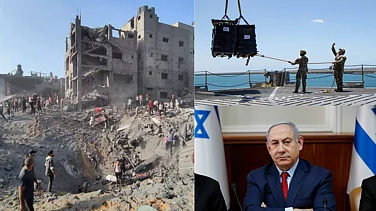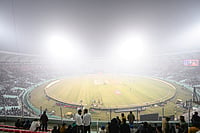A serene October morning was violently shattered as the sky lit up with fire over the Israeli housing settlements of Kfar Aza, Be’eri, Nahal Oz and Magen. These normally quiet neighbourhoods—bordering the endangered Gaza Strip—were transformed into a horrific scenario when they were caught in a ferocious storm of steel orchestrated by Hamas militants.
Even before the sun had chased away the night, these fighters, like shadows, used every means possible to penetrate southern Israel. From simple motorbikes to unconventional paragliders, they invaded peaceful sanctuaries, marking their paths with devastation and spreading the echoes of a conflict thought to be over.
In the days that followed, rescue teams sifted through the rubble, unearthing not only the structural, but also the human cost of this unforeseen collapse. Some 1,300 people, including 279 soldiers, were recovered from the rubble.
In the rubble of Kibbutz Be’eri, the story of 74-year-old Vivian Silver, an ardent advocate for peace, merged with tragedy. Her house stood—or rather, it no longer stood—as a cruel paradox of her lifelong mission to build bridges where walls stood. Vivian, known for her flamboyant activism, now bore the mute title of the missing, reinforcing the deep vacuum in the corridors of regional peace building. For outside journalists who wanted to cover Palestine issues, particularly in Gaza, she was the first stop to get quotes.

This bleakness was juxtaposed with the horrific reality that confronted visitors to the Nova Music Festival. An event meant for celebration turned into a theatre of horror as 260 lives were choked by the conflict; some were held hostage and tugging at the fragile threads of hope that connected them to their loved ones. One such story was that of 22-year-old Omer Wenkert, whose harrowing texts to his family serve as a testimony to the rapid descent from joy to despair.
The scene of the conflict, however, was not confined to Israeli soil. Tragedy struck when Al Ahli Arab Hospital was hit by an Israeli strike, leaving around 500 people dead, including patients, heroic medics and shelter seekers. Ibrahim Mukarram, who sought refuge there with his family, survived by sheer chance. Just three miles from the scenes of the initial chaos, Gaza itself shook under the weight of retaliation. The countryside burned like blisters under Israeli airstrikes. As the days passed, the death toll in Gaza rose immeasurably, with over 3,000 people, including 750 children, wiped out.
Marc Garlasco of PAX for Peace illustrates the intensity of the conflict by comparing Israeli airstrikes in one week to the scale of an entire year of US operations in Afghanistan. In just one week, Israel dropped 6,500 bombs on densely populated urban areas. “The highest number of bombs and other munitions dropped in a year during the war in Afghanistan was just over 7,423,” he said, citing US military records.
A former Pentagon strategist, Garlasco’s findings paint a grim picture of the scale and human cost of the conflict. He said the NATO alliance dropped about 7,600 bombs and missiles from aircraft throughout the war in Libya.
Existential Crisis
Gaza, a 40-km strip of land synonymous with endurance, is now reeling under an existential crisis, with displaced people reflecting a sense of confusion and hopelessness. Residents like Jumaa Nasser and freelance journalist Aseel Mousa recounted their harrowing journeys in search of refuge; their narratives punctuated by the relentless cacophony of bombardment. In a phone conversation, Mousa says there is no place that is safe. “There are no bomb shelters. The Israeli bombardment continues unceasingly. The sounds are terrifying,” she said. She is one of more than a million Palestinians who have been told by Israel to flee to the south of Gaza if they want to live.
For seasoned observers, the Hamas offensive did not come without precursors. The fuse for this explosive violence was lit by an increasing number of violent incidents in the occupied West Bank, failed diplomatic efforts, provocations at holy sites and a controversial settlement policy.
The year 2023 brought a frightening increase in casualties. The Palestinian death toll had reached its highest level since 2005, and attacks by Israeli settlers increased significantly. Tensions had escalated and extremist Jewish groups, emboldened by government support, were fuelling unrest not only among Muslims, but also in Christian communities.
The outbreak of violence from the Gaza side, however, was unexpected. Analysts and even Israeli strategists had predicted uprisings like the intifadas in the West Bank or protests within Israel’s significant, but marginalised Arab population. This miscalculation had led to a critical redeployment of forces, leaving Israel’s southern flank unprotected.
Many believe that an overconfident Prime Minister Benjamin Netanyahu has deployed half the Israeli army to protect settlers in the occupied West Bank. For the Sukkot festival, several battalions were moved from the Gaza border to Huwwara near Nablus to protect a revenge festival initiated by an extremist member of the Israeli parliament.
The broader context includes the complex geographical and political structure of the Palestinian territories and the systemic inequalities faced by Arab Israelis despite their nominal status as citizens. A recent Amnesty International report reinforces these concerns, describing institutional discrimination to the point of denying Bedouin (desert) villages basic services. Thirty-five Bedouin villages, home to some 68,000 people, are currently “unrecognised” by Israel, meaning that they are cut off from national electricity and water supplies and repeatedly targeted for demolition. According to the report, Palestinians, whether they live in Gaza, East Jerusalem and the rest of the West Bank, or in Israel itself, are treated as an inferior group of people and systematically deprived of their rights.
Gidon Levy, a well-known Israeli columnist, says there were many provocations over the past many years that were building up “lava beneath the surface”. The media images of Jewish worshippers sitting on a street in the middle of a Palestinian town, swaying back and forth like so many ritual palm fronds, are among the most grotesque in recent times.
“The grotesqueness soon gave way to disaster: because of this defiant, criminal provocation by the settlers, the residents of southern Israel had no one to protect them when Hamas forces invaded,” he said.
The conflict, however, is a rude awakening for Israeli, Western and Arab diplomacy, which had hitherto left the Palestinian issue out of the equation. The Israeli leadership particularly, in its exuberance, had ignored the expressions of displeasure, and instead, chose a path that has proven futile time and again in history: the illusion of peace through dominance. Ministers like Itamar Ben Gvir and Bezalel Smotrich became provocateurs, denying political legitimacy to Palestinians living in the occupied territories. The old Israeli policy of exchanging land for peace has clearly been consigned to the dustbin of history.
Long-term Consequences
As the dust settles from the immediate violence, the long-term consequences are emerging, reminiscent of the psychological aftermath of the Yom Kippur War. Questions are emerging that resound through the corridors of power, asking for accountability for the intelligence failures that led to the blinding of an entire nation.
Revelations in The New York Times suggest that the escalation caught Israel unprepared despite prior intelligence warnings from the Central Intelligence Agency (CIA), reigniting the debate about the effectiveness of intelligence communications and the possible miscalculations of Israel’s defence mechanisms, including the respected military intelligence unit 8200.
On September 28, CIA’s classified report had pointed to the possibility of Hamas firing rockets at Israel over several days. The second report on October 5 repeated this warning. On the same day, Hamas said that two of its members had been killed in the West Bank in a firefight with Israeli forces. The report went on to say that Hamas’ growing frustration with the longstanding Israeli blockade of the area could lead to a resumption of border attacks.
The reality on the ground is changing rapidly as Israeli forces are now entering the devastated landscape of Gaza. The military’s revelations to a news website, Middle East Eye, outline a future full of uncertainty, dependent on the vagaries of a large-scale operation. The presence of Israeli forces promises a protracted engagement and portends a future in which borders will blur and lives will undoubtedly continue to be uprooted. In addition to its regular army, Israel has recalled 360,000 reservists—or four per cent of the total Israeli population—to join the country’s fight against Hamas.
An Israeli colonel, who does not wish to be named, said the army had divided the enclave into several sectors and “determined which points and settlements [in the Strip] will be surrounded”, adding that “special operations will be carried out in at least 25 points in the sub-sectors”.
The officer explained that in the event of a ground invasion, Israeli soldiers could remain in the Gaza Strip for an extended, as yet undetermined period of time.
The colonel told the news website that Israeli military officials expect Hamas to be able to resist Israeli forces for up to three months, but that any offensive by the Palestinian group could change the course of the Israeli military operation.
“Various scenarios have been discussed about what Hamas would do. If there is a direct conflict and not on the basis of special operations, the borders of the Gaza Strip could change de facto. That is why the civilian population is being asked to leave,” he said.
The colonel also said that the army would remain there indefinitely if Hamas capitulated and did not put up fierce resistance together with other Palestinian groups. He added that Israeli forces stationed in the Gaza Strip would conduct operations against the Hamas network, including the group’s military leaders and the maze of tunnels it has built.
However, he said that a ground operation would be “hell” for Israeli reservists who had not received proper training, and acknowledged that the military was struggling with the number of Special Forces needed for such a large operation.
Jack Khoury, an Israeli strategist, however, calls for a careful consideration of the ‘next steps’ after the military offensives. He stresses that while revenge actions offer immediate emotional relief, they often lead to complex, long-lasting problems. Gaza’s proximity to Israeli borders further complicates the potential impact. The focus should be on what comes after Hamas is wiped out, who will govern and rebuild Gaza, and what will be the strategic long-term plan beyond the immediate conflict.
After the terrorist attacks of 2001, the US went to war in Afghanistan and Iraq. Its aim was to topple the Taliban regime and Al-Qaeda first, and then Saddam Hussein’s regime as well. Two decades later, not only are the Taliban back in power in Kabul, but Iraq has also been handed over to Iranian proxies, making the country even more dangerous for the Americans.
The immediate victim of the Hamas attack and the Israeli retaliation was the Abraham Accords, or the Arab-Israeli pacts, which included Bahrain, the United Arab Emirates, Sudan and Morocco, and earlier Egypt and Jordan. Saudi Arabia was soon to be added to the list, for which US Secretary of State, Antony Blinken, planned a visit. He did visit the region, but the whole dynamics had changed. Hamas has shown the signatories of the normalisation agreement that neglecting the Palestinians is a mistake. Israel and its Arab partners need a new, optimistic vision for Gaza and the West Bank.
Levy said Israel should not misunderstand the sympathy and solidarity that much of the outside world is currently showing. Much of the responsibility now lies with the international community. Visits by high-ranking American and European officials and the resoundingly sympathetic speech by US President Joe Biden should not mislead us. It must be clear that despite the understandable, friendly human compassion expressed, Israel’s response cannot be unrestrained.
As the region grapples with the immediate aftermath and the international community digests the implications, it is clear that Hamas’ attack has benefited many.
For Iran, the Abraham Agreement is dead. For Russia, it is a boon, as attention has shifted from Ukraine to the Middle East, and for the US, Israel’s invincibility is shaken as the Jewish nation’s dependence on Washington has been reasserted. Expecting to stabilise the region, the US wanted to shift its resources in the Middle East to the Asia-Pacific region to counter a rising China. This will give Beijing breathing space, while the US is sucked in the region with all its major aircraft carriers.
Everyone has won, but at the cost of Palestinian lives. It has also shown that the road to peace is becoming more and more tortuous and old strategies are crumbling under the rubble of new conflicts.
(Views expressed are personal)
Iftikhar Gilani is a journalist currently based in Ankara, Türkiye



























